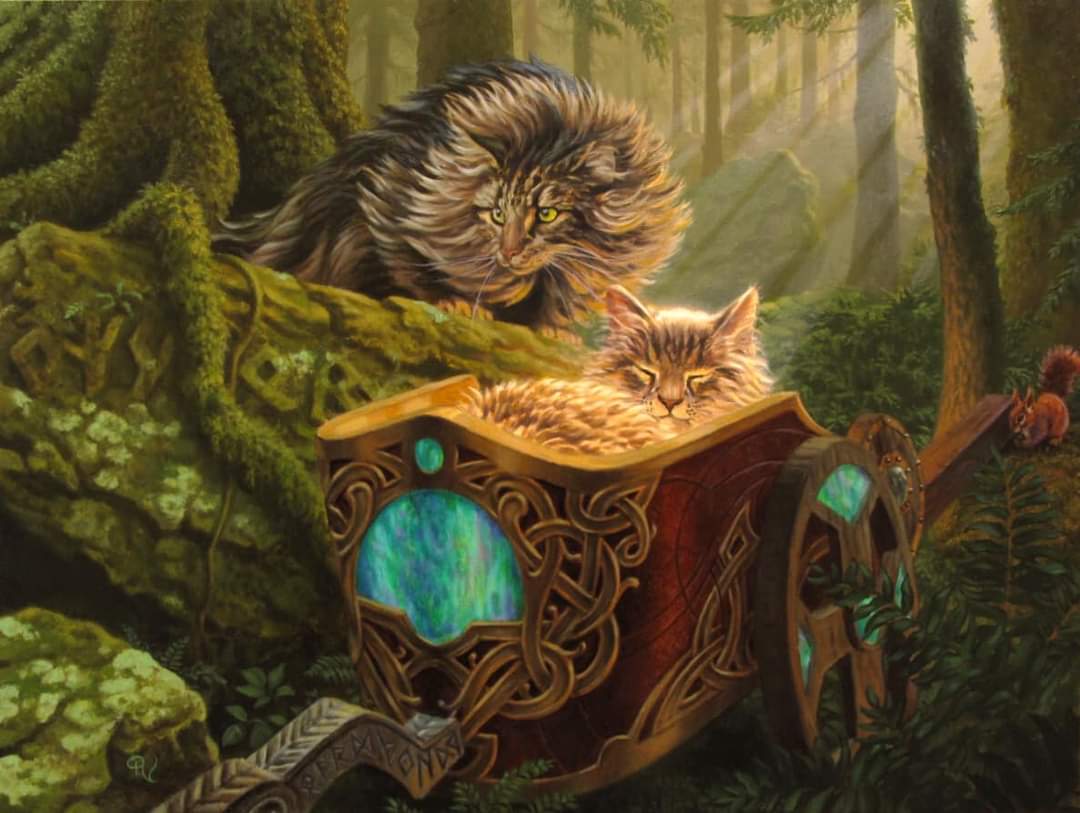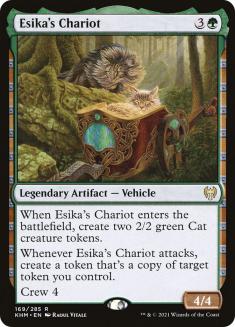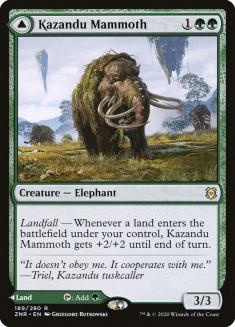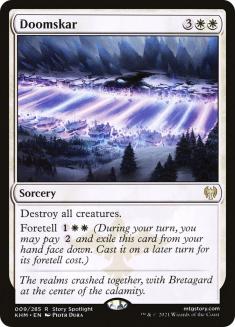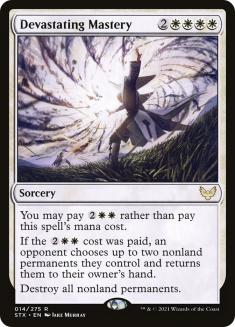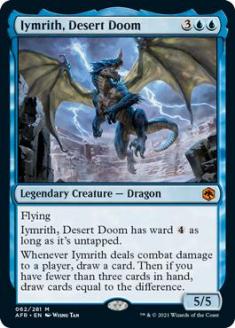Ever since I started making VS Live! preview season has taken a different tack. Rather than focus on a few things that are most interesting to me, I try to look at a wide spread of possible new cards and the decks they enable. This often means that the decks we play need serious updating once the new set goes live on MTG Arena and millions of games happen in a matter of days.
However, the benefit to this new approach is that I often get a strong, big-picture view of the new format. These guidelines are a great base to approach a new format, and often stay relevant well into the metagame’s development. So now that you’ve all been turned loose into the wide world of Standard post-Throne of Eldraine, I’d like to share with you the lessons I’ve learned from mine and Corey’s head start exploring this new Standard format.
1. Esika’s Chariot Is the Truth
Okay, I’m starting with an easy one. Throughout the last few weeks on VS Live! the card has been simply fantastic, and that played out last weekend in MTGO Challenges and the Hooglandia Open on Arena. There are three to four copies of it in nearly every green deck, even with Arlinn, the Pack’s Hope as another strong option for Gruul players.
At this point, Esika’s Chariot is Public Enemy No. 1 for Standard players everywhere, so expect cards like Cinderclasm that can clear away a pile of Cat tokens to increase in prominence, along with Prismari Command — a spell that’s versatile enough to maindeck in an open metagame that also answers the Chariot itself.
But more importantly, the emergence of Esika’s Chariot as a format-defining card means that cards that synergize well with it gain status in the metagame. I wrote last week about the power of Briarbridge Tracker with Chariot, but that’s not the only card that Chariot is pushing to the forefront.
Reckless Stormseeker is also great with Esika’s Chariot, letting you immediately attack and create a token. This curve puts your opponent under immense pressure, forcing them to disregard the highest-value plays they have if they don’t sufficiently protect their life total. But at the same time, you’re generating value of your own, thus putting yourself in position to win both a short game and a long game. Attacking on multiple fronts is critical to winning in competitive Magic these days, and I expect Briarbridge Tracker and Reckless Stormseeker to be the default three-drops for Gruul decks moving forward.
The other breakout card from last weekend, in large part due to its synergy with Esika’s Chariot, was Wrenn and Seven. The ability to copy large Treefolk tokens with Chariot lets you run away with games rather quickly, but there’s another subtle reason why these two cards play so well together. It comes from the reach of those Treefolk. Esika’s Chariot is great at dominating the ground because it can play offense or defense and go wide or tall as necessary. But if you fly over it with Goldspan Dragon or Moonveil Regent you limit its effectiveness.
Wrenn helps ensure that you have control of the air as well as the ground, making it nigh-impossible to come out ahead in combat. It’s to the point where Wrenn is overtaking Goldspan Dragon in Gruul lists, and I won’t be surprised to see that trend continue, despite how strong of a card Goldspan Dragon is.
On the other side of this equation is Kazandu Mammoth, a former staple that I foresee falling on hard times now that it has competition from Briarbridge Tracker and Reckless Stormseeker, and lacks the cards that helped it rise to prominence last season. Much like Tracker and Stormseeker play well with Chariot, Mammoth played well with The Great Henge, curving perfectly into a Turn 4 Henge with any untapped land.
That beefy five power also helped power through Lovestruck Beast or end games with Embercleave, but now is likely to trade down with a pile of tokens. A 5/5 on defense would be nice now against Chariot, but Mammoth can’t do that without Fabled Passage, which also rotated. You can try to recreate the magic with Evolving Wilds, but it’s not going to be the same.
So more than Esika’s Chariot being something you need to prepare for, this lesson is about figuring out the more subtle impact that the top cards have on the metagame. Cards that did nothing last year could be staples this year, and vice versa. So don’t rely on your knowledge from previous Standard seasons too heavily. It’s a whole new world out there.
2. Attrition Magic Is Back
With the power of Edgewall Innkeeper letting aggressive decks play into the long game and the over-the-top, game-ending power of Emergent Ultimatum and Into the Story, it was a rough year for midrange decks that look to attrition their opponents with a pile of card advantage generating threats and quality removal.
But those cards are gone now, and that means Standard can return to its midrange, attrition roots. You can see this in the Top 4 of the Hooglandia Open, where such decks appeared in Selesnya, Orzhov, and Jund flavors. Moreover, a Rakdos midrange deck took down Sunday’s Standard Challenge on MTGO. All of these decks are piles of card advantage, removal, and threats, with plenty of cards that fall into multiple of those categories.
I suspect the early days and weeks of this new metagame will largely be the story of figuring out exactly which midrange decks are the best when there are so many similar options. And the answer to that question comes from the aspect of Magic that players most often ignore: the mana. Mana sets the limits of what’s possible, and the more you can stretch your mana without sacrificing consistency, the more adaptable your deck will be in a dynamic metagame.
With mana fixing from Treasures, Jaspera Sentinel, Lotus Cobra, Pathways, and the new slow lands, I think you can play three colors. I’d err towards the Shard color combinations here, that is Jund, Esper, Grixis, Bant, and Naya, since those are the trios that get two different slow lands. Do you want better removal, discard spells, and Immersturm Predator in your Gruul deck or maybe Showdown of the Skalds for more card advantage? I’m not sure what the right answer is between those two options, but I’m not interested in limiting myself to just Gruul.
That third color opens up so many more options to tailor your removal and threats to beat the most popular decks, and staying within the color combinations that offer the most mana fixing from quality (i.e. non-Snarl) lands minimizes the loss in consistency. I’m not surprised that most players are sticking with two colors for now because there are certainly enough quality cards to fill out a list, but the end-game for midrange decks is going to be three-color lists.
3. White Is a Support Color
Magic’s worst color hasn’t been done any favors with rotation. Mono-White Aggro largely survived rotation, but I don’t see a resurgence because it lost the density of good one-mana creatures such decks rely on, most notably Giant Killer. Current lists are bloated at two- and three-mana plays, which makes it hard to get underneath the midrange decks while being disadvantaged in the late-game against them.
I think there’s some potential for control decks playing Doomskar and/or Devastating Mastery as powerful sweepers, but for now white is merely a support color. There are definitely some quality cards in the color, notably Skyclave Apparition and Elite Spellbinder, but there isn’t enough to carry an archetype. White’s best haymakers, Elspeth Conquers Death and Yorion, Sky Nomad, rotated with nothing at that level to replace them.
So if you’re looking to play Esper, Bant, or Naya, I’d look to build them as base Dimir, Simic, and Gruul respectively, relegating white to a splash for key gold cards like Vanishing Verse or Showdown of the Skalds.
There just isn’t a real reason to be drawn into a heavy-white deck. Skyclave Apparition and Firja’s Retribution are about the only cards with multiple white symbols in their mana cost that I’m interested in casting right now, and that’s not enough.
White’s power remains in its aggressive elements, like Usher of the Fallen and Luminarch Aspirant. But until there’s a critical mass of quality cheap creatures to make a Mono-White Aggro strategy work, it will once again be the worst color in the format.
4. Avoid Tribal Aggro
Continuing to consider aggro decks, Corey Baumeister and I consistently found the tribal decks to be lackluster, despite how powerful some of the cards read on paper. Both Vampires and Zombies had awkward curves because there are not enough one-mana threats that are on-tribe. Compounding upon that, playing two colors in order to take advantage of tribal payoffs like Bladestitched Skaab and Vampire Socialite introduced even more inconsistency.
Even Werewolves, a tribe replete with powerful creatures and better mana from the green mana fixing, played better when you weren’t overly concerned with tribal payoffs. Reckless Stormseeker and Werewolf Pack Leader are great cards by themselves, and you can support them with Esika’s Chariot and Wrenn and Seven just as easily as you can with Tovolar, Dire Overlord and Unnatural Moonrise.
I’ve noticed a trend in tribal aggro decks underperforming in recent years, with rare exceptions like Orzhov Vampires with Sorin, Imperious Bloodlord. In part I think it’s because the removal of blocks means that any given tribe doesn’t get as much support. The next set is likely to be on a new plane with different tribes to support, so you get a wide array of half-built decks that struggle to find playable cards to fill out their lists. Sometimes there’s enough there to build a Tier 2 deck like Knights, but more often they all just fall short.
Secondly, there’s the issue of most tribes appearing across multiple colors, and it’s tough to build a multicolor manabase for aggressive decks these days. Pathways are great, but slow lands are awkward for aggressive decks, and two dual lands aren’t enough to make a true two-color manabase work consistently. If you have to limit yourself to one color to make your mana work, it’s even less likely that you’ll have a deep enough pool of creatures in a single tribe to fill out a complete deck.
Lastly, there’s the simple reality that the payoffs for tribal decks just aren’t that good. Champion of the Perished is the best from the recent set, since it has huge upside for a low cost, but lords, even at two mana, aren’t particularly exciting. It’s no surprise that the most recent exception to tribal decks falling short, Orzhov Vampires, had an incredibly powerful payoff in Sorin, Imperious Bloodlord, which has also formed part of the basis of a competitive Vampire deck in Pioneer.
When you build a tribal aggro deck, what you’re saying is that the gains you get from developing those synergies are greater than the costs in playing weaker individual cards and/or worse mana. The payoffs right now aren’t there, and the costs are too high. If you’re looking to beat down in Innistrad: Midnight Hunt Standard, I’d stick to one color, likely red or green, and strongly consider a snow manabase for Faceless Haven. Aggro decks succeed when they can consistently get under the metagame, and those are the best decks at doing that.
5. Control Decks Should Be Tapping Out
Dimir Rogues was the default control deck for nearly two years. It’s the absolute pinnacle of draw-go decks, with nothing but cheap flash threats to win the game with, plenty of counterspells and removal, and an incredible piece of card advantage in Into the Story. There are certainly flash threats left you could play, and Memory Deluge is a very strong card draw spell. But you’re missing on the cheap flash threat part.
Plenty of control decks have existed with a few expensive win conditions, so that may not seem like a big deal, but I don’t see how counterspell-based control decks can effectively turn the corner in this format. There are too many threats that you just can’t allow to resolve because they are so hard to answer, and the quality of removal in Standard went way down with the rotation of Heartless Act and Extinction Event.
Corey and I tried many counter-heavy control decks, as well as more aggressive lists with Delver of Secrets. None of them showed a consistent ability to stay at parity through the early-game, which made their wealth of counterspells a liability. I’ve come to the conclusion that I don’t want to be casting any Cancel variants in this Standard environment.
That doesn’t mean control is unplayable. It just means you have to adapt, and move to the tapout style of control, which on paper looks a lot like a midrange deck that has cut its cheap creatures for more interaction. I ended up building a Grixis Control list in that vein and was quite impressed with how it played, though I admit that Corey’s Dimir Zombies list wasn’t the toughest competition.
The Celestus ends up being an important mana fixer that gets you to your sweeper a turn earlier, no matter if that sweeper is Shadows’ Verdict, Burn Down the House, or Doomskar, and it plays particularly well in black or red decks because you can minimize the tempo loss by immediately casting Bloodchief’s Thirst or Play With Fire. The non-Manalith text on the card is a nice bonus for the long game, but not essential to the card’s place in the deck.
I also like that Iymrith, Desert Doom plays defense against powerful threats like Goldspan Dragon and Esika’s Chariot while being difficult to remove, so it’s the safest threat to tap out for. It plays nicely with Shadows’ Verdict, which is why I went for the black sweeper, and just so happens to power up your Dragon’s Rages.
Here’s an updated list of the deck:
Creatures (7)
Planeswalkers (1)
Lands (23)
Spells (29)
- 2 Island
- 1 Negate
- 2 Disdainful Stroke
- 3 Bloodchief's Thirst
- 1 Sea Gate Restoration
- 1 Hagra Mauling
- 3 Shadows' Verdict
- 2 Prismari Command
- 4 Expressive Iteration
- 1 Power Word Kill
- 2 Check for Traps
- 3 Dragon's Fire
- 1 Infernal Grasp
- 3 The Celestus
Sideboard

Note that this deck isn’t completely devoid of counterspells. But Negate and Disdainful Stroke play a key role in stopping some of the format’s most powerful threats at a cost that makes it much easier to double-spell and actually pull ahead on the battlefield. Casting a removal spell along with Disdainful Stroke on Turn 4, for example, is a great play that likely sets you up to cast Iymrith on a stable battlefield on Turn 5.
You could build a similar control deck in other color combinations should you have good reason to, but for the current metagame I like the combination of black and red removal and card advantage from Iymrith and Expressive Iteration. I also think Tibalt, Cosmic Impostor is among the most powerful late-game threats, and unlike similar cards, it can be relevant early on against aggro.
With such a huge change coming from rotation, it’ll be several weeks before a well-defined Standard metagame emerges. But even in these Wild West stages of the metagame, there are patterns emerging that we can learn from and use to build better decks. These guidelines will shape how I build and select decks for the coming weeks, and I think they’ll serve you well, too.

